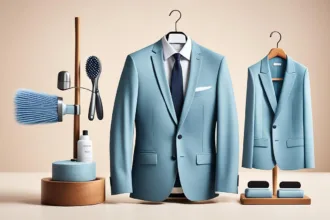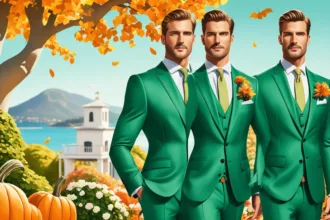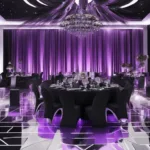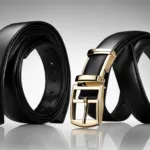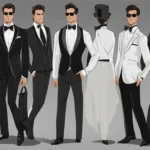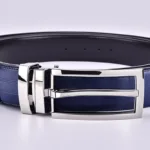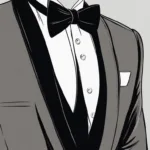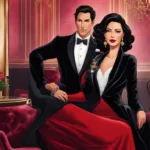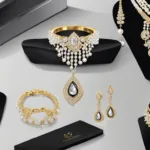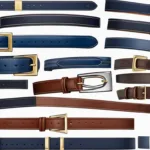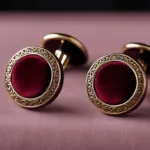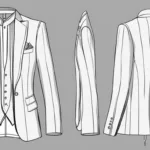When preparing for a formal event, understanding the nuances of the black tie attire color guide is crucial for making a lasting impression. While the term ‘black tie’ conjures images of classic sartorial elegance, it’s a common misconception that your options are limited to the darkest end of the color spectrum. In fact, selecting suit colors for black tie events can be less restrictive than many believe.
The history of black tie attire is steeped in tradition, tracing back to the aristocratic circles of the 19th century. Yet, even the earliest adherents understood the power of personal expression within the dress code. Today, this understanding allows for a judicious selection of hues that can range from the timeless midnight navy to a more contemporary charcoal gray. However, the foundation of the black tie, classically rooted in monochromatic color schemes, has remained consistent. Mastering the balance between tradition and personal style is key to nailing the classic black tie color schemes.
Key Takeaways
- Black tie attire incorporates a wider palette than just black, allowing for refined color variations.
- Heritage and modernity blend in selecting shades suitable for black tie, with options like navy and charcoal.
- Understanding color choice is as important as the fit and fabric quality in black tie dressing.
- The right color scheme amplifies the sophistication of the attire while adhering to formal dress codes.
- Occasion, venue, and time of day influence the appropriate color selection within black tie standards.
The Significance of Black Tie Attire
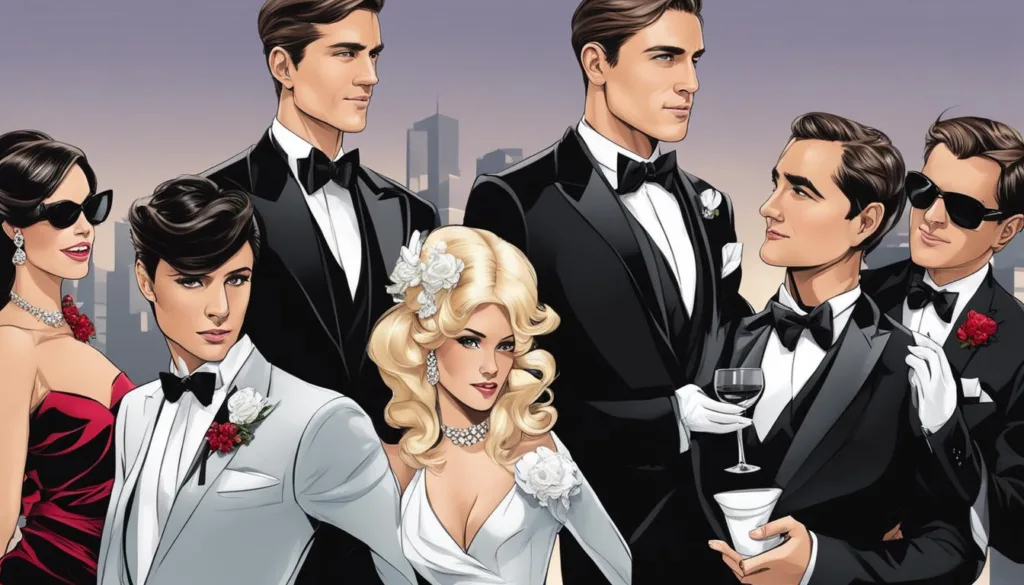
As the embodiment of sartorial elegance, black tie attire has transcended merely being a fashion statement to becoming a distinguished symbol of sophistication and respect for various formal events. The nuances of black tie color etiquette drive the importance of adhering to certain standards, while mixing and matching colors for formal events allows for personal expression within an established framework. Let us explore the legacy and intricacies of black tie attire, demonstrating its pivotal role in contemporary society.
The Evolution of the Black Tie Dress Code
Originating from the aristocratic roots of the 19th century, black tie attire has continually adopted subtle changes to complement contemporary tastes while maintaining its classic foundations. Signifying prestige and grace, the modern black tie embodies both comfort and style, offering distinguished pieces such as the tuxedo and dinner jacket. This evolution reflects a balance of historical respect with present-day aesthetic sensibilities.
Identifying the Right Occasion for Black Tie
Understanding when to don black tie attire is paramount, as its presence is typically reserved for evening events that denote a high level of formality, such as gala dinners, operas, and certain weddings. The appropriate application of this dress code becomes a clear indicator of one’s awareness of social protocols and consideration for the event’s tone and significance.
The Importance of a Proper Fit and Quality Fabric
Ensuring a flawless presentation in black tie attire not only consists of choosing the right color palette but also demands meticulous attention to the garment’s fit and the quality of the fabric. A bespoke suit that adheres to the wearer’s measurements guarantees a streamlined silhouette that resonates with timeless fashion – an investment in the essence of elegance that stands a cut above the ordinary.
Selecting Suit Colors for Black Tie Events
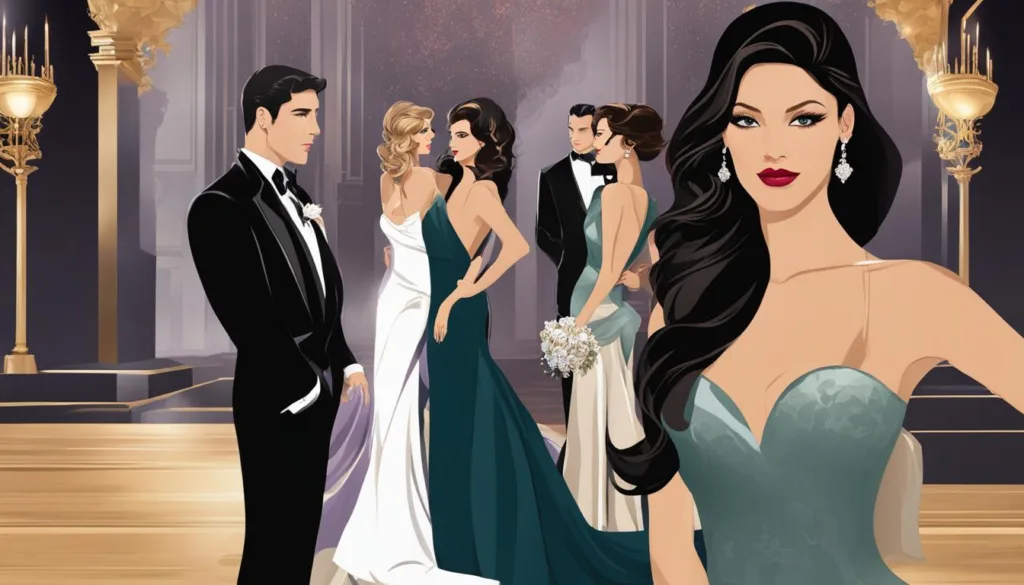
When deciding on black tie suit color options, it is essential to consider the level of formality of the event, the time of year, and how the color complements your skin tone. While black has long been the standard for these occasions, there are now more elegant color choices for black tie that provide discerning individuals with room to express their style without straying from the dress code’s elegance.
Navy Blue: A Timeless and Versatile Choice
Navy blue is the epitome of sophistication and versatility. Its deep tones offer a softer alternative to black while still aligning with the formality required for black tie events. Particularly compatible with a variety of accessories, navy blue suits can adapt to both night and day functions with equal aplomb.
Charcoal Gray: A Subtle Alternative to Black
For an option that is formal yet somewhat less intense than black, charcoal gray stands as a formidable choice. This color is particularly fitting for those who prefer a softer color profile. Charcoal gray brings a contemporary edge to the classic dress code, maintaining the traditional black tie’s gravitas without the stark contrast of a black suit.
When to Choose a Classic Black Tuxedo
Reserved for the most ceremonial and distinguished occasions, the classic black tuxedo is the foundation of black tie attire. This traditional option is the safest bet for any event that specifies a strict black tie dress code, exemplifying a timeless elegance that is unmatched.
| Color Option | Formality Level | Seasonal Suitability | Time of Day |
|---|---|---|---|
| Navy Blue | High | All Seasons | Day to Evening |
| Charcoal Gray | Medium to High | Mostly Autumn & Winter | Day to Early Evening |
| Classic Black | Highest | All Seasons | Evening to Night |
Whether opting for a timeless navy, a subtle charcoal gray, or the quintessential classic black, the correct hue can define your presentation, assuring that you are dressed appropriately for the occasion while also allowing room for personal style within the black tie framework.
Classic Black Tie Color Schemes
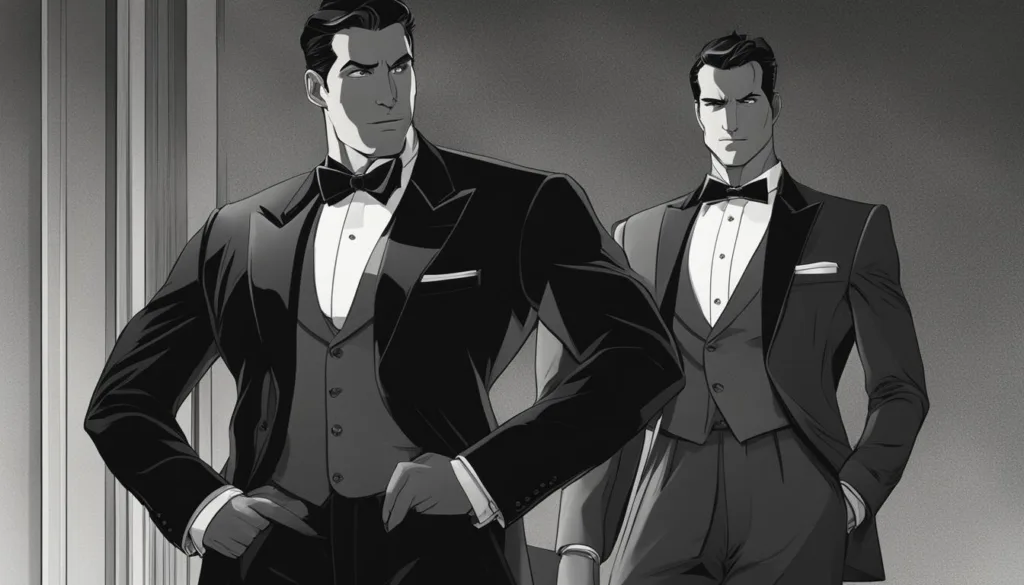
The essence of classic black tie color schemes lies in their ability to exude a sense of unquestionable elegance. Embracing the heritage and formality of traditional black tie events, certain color palettes have become synonymous with refinement. Stark black and midnight navy emerge as pillars of style, offering a canvas for personal expression within delineated parameters.
Contrary to the assumption that black tie is rigidly monochrome, the modern sartorial landscape allows for measured creativity. While the backbone of a classic black tie ensemble remains within the realm of dark, solid colors, contemporary practices permit the integration of rich textures and subdued patterns, ensuring that attendees present a polished yet individualistic demeanor.
| Color | Occasion | Complementing Textures | Ideal Accessories |
|---|---|---|---|
| Stark Black | Gala Events, Operas | Barathea Weave, Satin Lapels | Bow Tie, Patent Leather Shoes |
| Midnight Navy | Weddings, Award Ceremonies | Herringbone, Grosgrain | Silk Neckwear, Polished Oxfords |
In recognition of the enduring allure of classic black tie color schemes, these foundations serve not only as a nod to tradition but also as a testament to the timeless aesthetic that black tie attire commands. Whether accentuating with a cummerbund or a pocket square, harmony between color, texture, and accessories is the linchpin of an immaculate presentation at formal affairs.
“In fashion, the classic black tie is not just a dress code but a canvas for sartorial storytelling, where each nuance of shade and texture narrates personal style with understated sophistication.”
For the connoisseur of classic formality, the charm lies in the details. Sophistication is orchestrated through the holistic consideration of each garment, ensuring that every element—down to the cufflinks—reflects a curated, cohesive look that respects the grandeur of black tie engagements.
Color Trends in Black Tie Attire
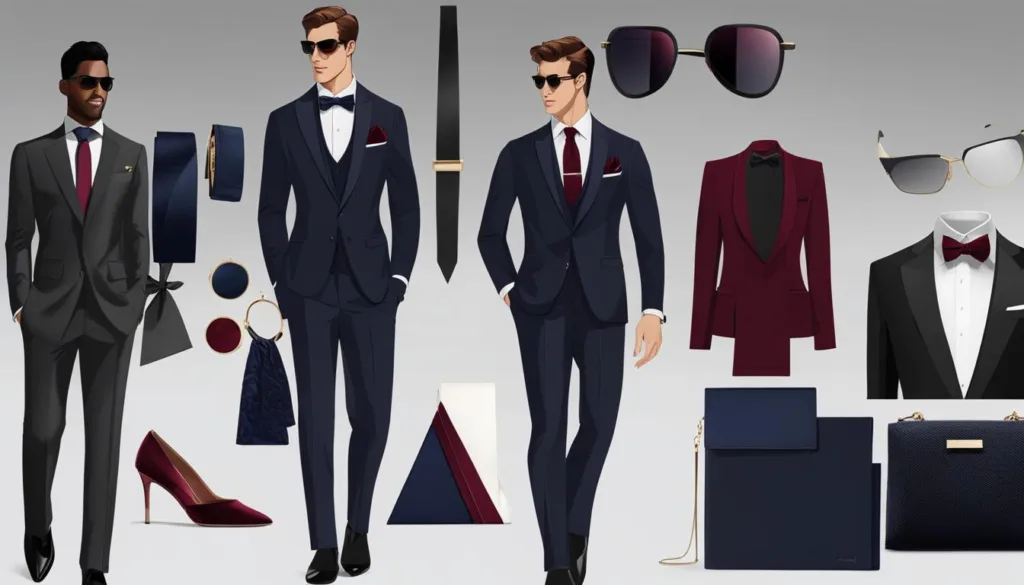
As fashion evolves, so do the color trends in black tie attire. No longer confined to the traditional palette, modern formal wear embraces a more diversified spectrum, encouraging the integration of contemporary trends into classic ensembles. From the runways to red carpets, discerning gentlemen and style connoisseurs are experiencing an exciting age where coordinating colors in formal wear can reflect personal style while remaining impeccably elegant.
Incorporating Textures and Patterns
Textured fabrics and patterns have emerged as a dynamic way to add distinction to black tie attire. Velvet and jacquard, with their rich tactility, bring a depth that standard materials lack. Patterns, when used judiciously, can introduce a subtle twist to an outfit—they are the sartorial nods to individuality and modern flair. Houndstooth, pinstripes, or even floral motifs can complement the baseline formal wear if chosen with a discerning eye for sophistication.
Selecting the Right Accessories for Trendy Colors
Accessories remain pivotal in accentuating the modern hues that now populate the palette of formal attire. The strategic use of cufflinks, pocket squares, and bow ties can highlight or balance the contemporary colors chosen for one’s evening ensemble. When coordinating colors in formal wear, accessories are the key components that can tie together or elegantly contrast the textures and tones of the suit, ensuring a cohesive and fashionable presence.
Understanding the Impact of Seasonal Color Trends
Awareness of seasonal color trends is essential for those aiming to stay at the forefront of fashion while donning black tie attire. Earthy tones could be woven into a fall wardrobe, while vibrant hues could be reserved for spring and summer soirées. While the colors may follow seasonal shifts, the inherent formality and polished aesthetic of black tie code remain unchanged, allowing for a seamless blend of tradition and trend.
Coordinating Colors in Formal Wear
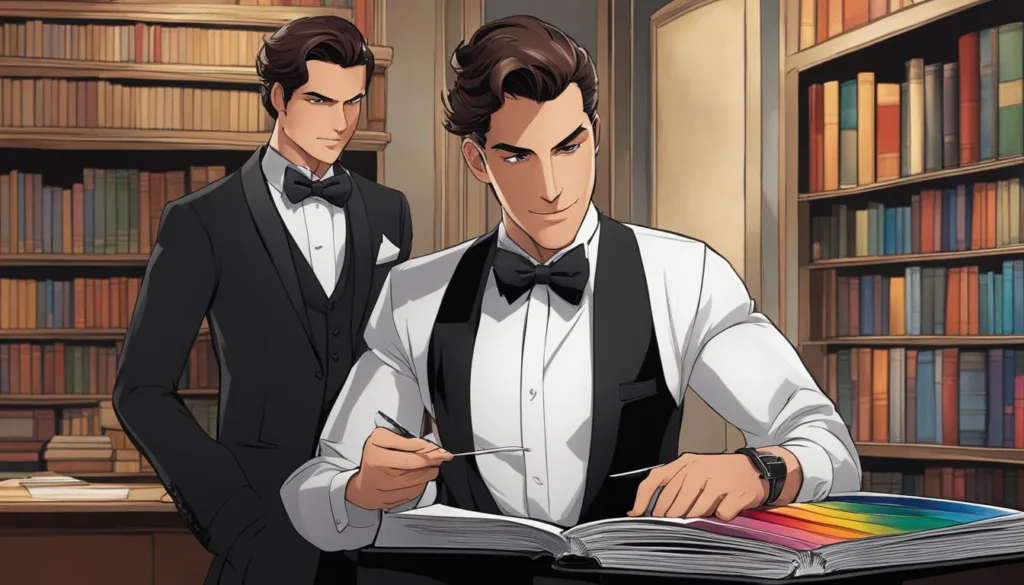
Mastering the art of color coordination in formal wear is a subtle dance between tradition and personal expression. It’s about creating a look that’s both timeless and tailored to the individual. Within the realm of black tie events, meticulous attention to the interplay of color enhances the overall sophistication and ensures a dramatic, yet elegant presentation.
The Role of Contrast in Black Tie Ensembles
In the world of formal wear, contrast isn’t just about black and white; it’s an expressive tool that can draw the eye and accentuate the finer points of a gentleman’s attire. A well-chosen jacket, for example, paired with a classic white dress shirt, cultivates an air of crisp refinement. When implemented skillfully, contrast can add depth to an outfit, especially when adhering to the restrained palette synonymous with black tie affairs.
Matching Accessories with Suit Colors
Selecting accessories that echo the hues of your suit isn’t just about matching colors – it’s about complementing them in a way that exudes elegance. From the silk of a tie to the sheen of a cufflink, every detail contributes to a harmonious composition that communicates both style and respect for the occasion.
Color Coordination Tips for Couples
For couples attending a high-formality event, synchronization in color choice can be a powerful visual statement. It’s not about wearing identical colors but rather finding a common thread – be it an analogous shade or a coordinating accent – that unites the couple’s look while celebrating their individual styles.
When considering how to best apply these principles to your next event, consult the following table which outlines ideal pairings and accessories that coordinate with different suit colors:
| Suit Color | Shirt Color | Accessory Suggestions |
|---|---|---|
| Classic Black | Pure White |
|
| Navy Blue | Light Grey or Ivory |
|
| Charcoal Grey | White or Pale Pink |
|
Remember, the goal is to blend traditional elegance with a personal touch, crafting a look that’s respectful of the formal setting while showcasing your unique sartorial perspective.
Black Tie Attire Color Guide: The Dos and Don’ts of Accessorizing
Accessorizing for a black tie event is an exercise in elegance and restraint. Understanding the color guide and the interplay between accessories and the primary attire can make all the difference in creating a look that’s as stylish as it is respectful of the dress code. Whether it’s mixing and matching colors for formal events or choosing the correct metallic finish for cufflinks, every detail contributes to the overall sophistication.
Finding the Perfect Balance with Studs and Cufflinks
When it comes to studs and cufflinks, choose pieces that enhance your outfit without overwhelming it. Opt for metals that complement the color scheme of your attire. For instance, silver or white gold are excellent choices for a sleek, modern feel, while yellow gold can bring a touch of warmth to traditional formal wear.
Choosing Between Bow Ties and Neck Ties
The debate between bow ties and neckties may continue, but tradition favours the former for black tie events. If you opt for a bow tie, ensure it matches the material of your dinner jacket lapels for a cohesive appearance. Satin or velvet bow ties are particularly suited for such occasions, adding texture and a subtle contrast.
Selecting Shoes That Complement Your Attire
Footwear should never be an afterthought in black tie attire. Patent leather shoes are a staple for adding a lustrous finish that echoes the formal nature of such events. Remember to ensure your shoes are polished to perfection—scuffs or lackluster footwear can detract from even the most impeccable tuxedo.
Elegant Color Choices for Black Tie
When it comes to selecting the ideal palette for black tie attire, one must consider colors that exhibit an air of elegance while respecting the formal nature of the event.
For those seeking to make a refined statement, deep burgundy offers a luxurious alternative that can stay within the bounds of formality when styled correctly. Similarly, hunter green presents an opportunity to stand out with a touch of earthy sophistication.
-
Navy blue remains a popular and versatile choice for its ability to command attention without straying too far from tradition.
-
The perennial black keeps its place at the top for its unrivaled elegance and ability to create a crisp, timeless look.
-
For a subtle variance, charcoal gray opens the door to formalwear that is refined without the stark contrast of black and white.
In each case, the key to success lies in ensuring the entire look is harmonious, from the quality of the tailor-made fabric to the luster of well-chosen dress shoes. Let’s not forget, the ultimate sophistication in black tie attire emanates from the whole ensemble, carefully pieced together with a discerning eye for color, texture, and detail.
Black Tie Color Etiquette for the Modern Gentleman
The landscape of formal attire is constantly evolving, and with it, the black tie color etiquette that has long governed the wardrobes of discerning gentlemen. In today’s sartorial climate, there is a subtle shift towards personal expression within the framework of tradition. A gentleman attending a formal event has the creative freedom to explore beyond the ubiquitous black and white palette—provided his choices are informed, fitting, and maintain the decorum of the black-tie code.
Understanding the Black Tie Code of Dressing
It is crucial for the modern man to comprehend the foundation upon which black tie attire is built. The traditional tuxedo—a masterpiece of tailored sophistication—is most commonly expected in shades of black or midnight blue. This formal requirement is designed to create an environment of uniformity and respect during significant occasions, emphasizing the event over individuality. However, the modern convention is more accommodating, accepting variations that still align with the underlying principles of elegance and uniformity.
Respecting Tradition with Modern Flair
The true spirit of the black tie color etiquette is not to restrict but to guide. Respecting traditional hues—such as the sophistication of a well-fitted black tuxedo or the deep elegance of a navy alternative—establishes a foundation upon which individual flair can be aptly displayed. A tasteful addition of color, whether through a tie, vest, or pocket square, introduces personality while respecting the classic dress code. Seeking a harmonious balance between old-school charm and modern style reflects an understanding of true black tie finesse.
Navigating Unconventional Color Choices with Etiquette
Introducing unconventional colors into black tie attire is a delicate art. While absolutes in fashion are few, the guidelines for mixing and matching colors for formal events demand a restrained hand. A burgundy jacket, for instance, can be striking—if you integrate it with the proper decorum and context in mind. Following this, we highlight a concise table to guide the modern gentlemen through the adopting of unconventional colors while remaining true to black tie etiquette:
| Color Choice | Appropriate Occasion | Suggested Pairing |
|---|---|---|
| Burgundy | Less traditional black tie events; Creative Black Tie | Black trousers, white shirt, black bow tie |
| Emerald Green | Holiday galas, festive occasions | Black trousers, white shirt, black velvet bow tie |
| Deep Purple | Autumnal events, evening weddings | Black trousers, crisp white shirt, silk bow tie in a subdued hue |
Adroitly displaying colors within the sophisticated frame of black tie dressing underscores a gentleman’s mastery in the art of modern formal wear. It’s the eloquent expression of one’s style narrative while respecting the heritage and significance of the black tie tradition that sets apart the modern gentleman at any formal event.
Conclusion
The essence of black tie attire is encapsulated by its enduring allure — an epitome of elegance that has stood the test of time while adapting to the evolving fashion landscape. Rooted in the historical prestige bestowed by King Edward VII, black tie attire upholds an esteemed tradition, offering a canvas for sartorial expression. As we navigate through a plethora of choices, this black tie attire color guide has illuminated the pathway to striking that delicate balance between the venerable customs of formalwear and the individualistic flairs of the contemporary gentleman.
Black tie dressing is not merely about adhering to a set of stringent guidelines; it’s an art that combines respect for ceremony with personal differentiation. The judicious selection of hues, from the steadfast black and navy to more modern palettes, embodies the gravity of the event while allowing personality to resonate through each stitch and seam. With the fundamental principle that every man’s wardrobe should contain a garment that signifies respect for grand occasions, black tie events become an opportunity to showcase one’s discerning taste for quality and suitability.
As we conclude, remember that the crux of wearing black tie is an understanding of the dress code, coupled with the execution of an attire stitched with class and distinction. Whether sticking to the traditional spectrum or veering towards a trend-forward aesthetic, each color choice and accompanying accessory should coalesce to form an ensemble that honors the prestige of black tie events. Armed with this comprehensive black tie attire color guide, the modern gentleman is well-equipped to approach his next gala with both confidence and style.
